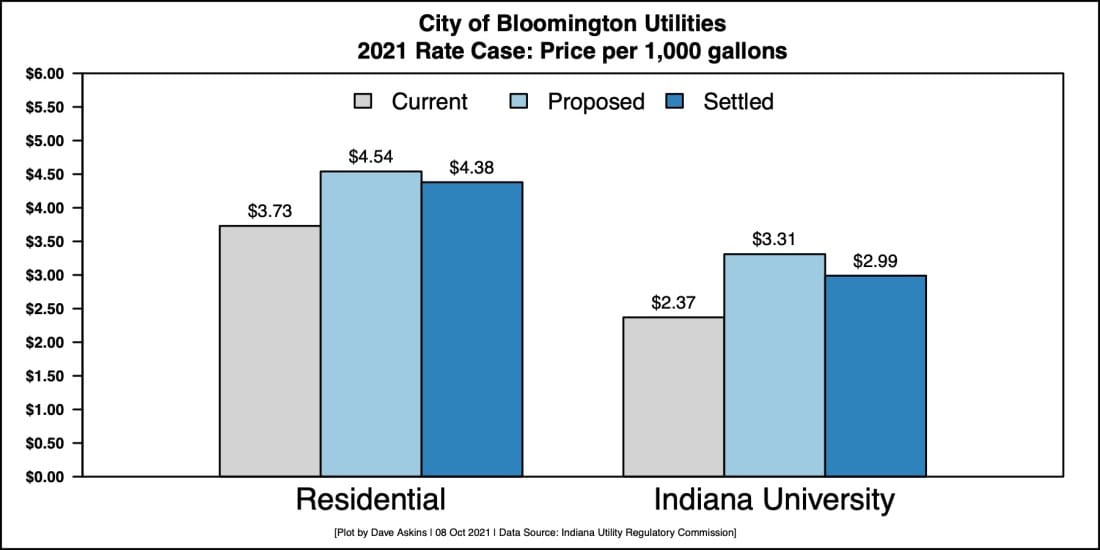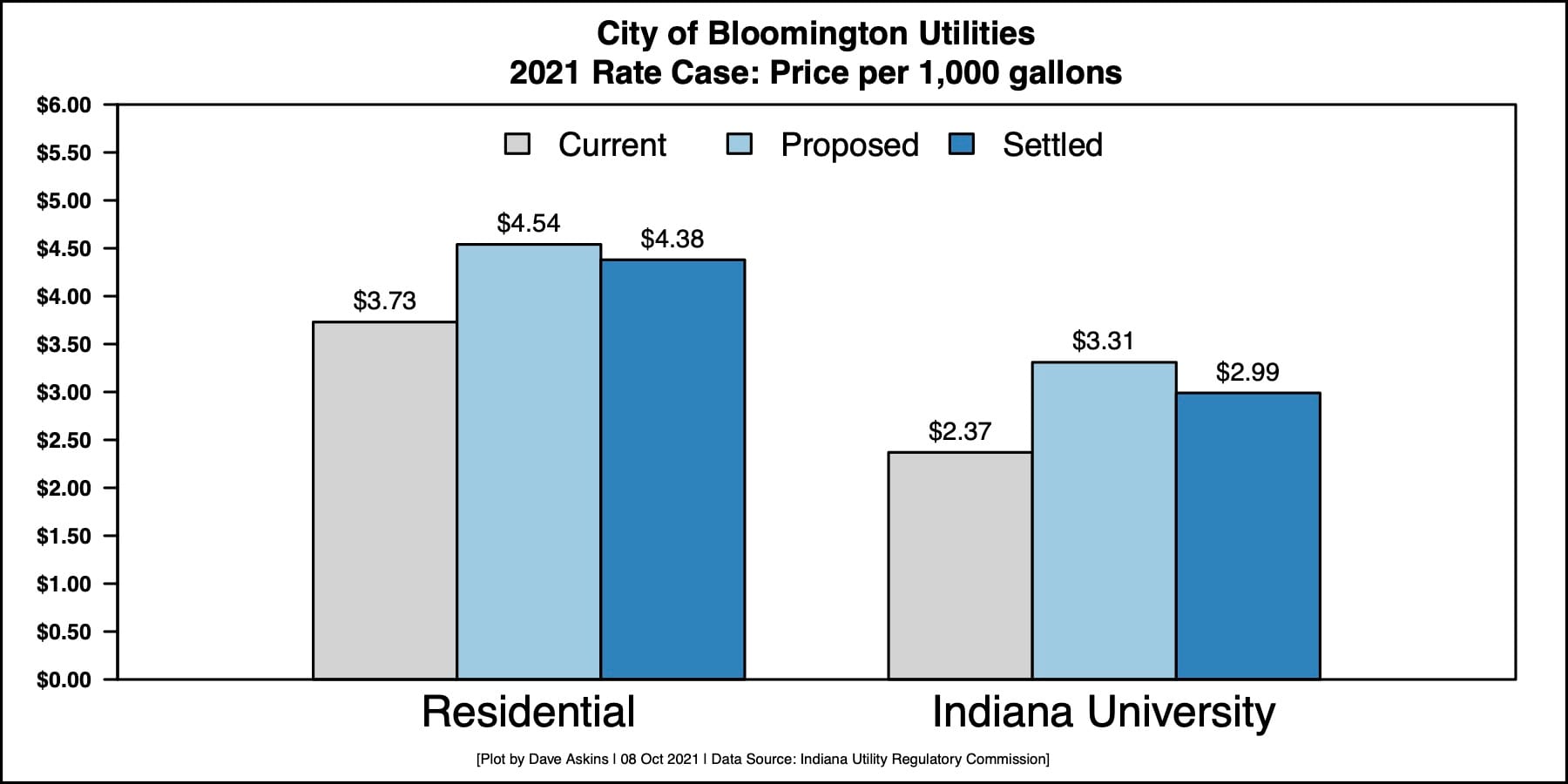Bloomington water rates will still go higher, but by less: Details of proposed settlement filed


Customers of city of Bloomington utilities (CBU) will be paying more for their drinking water starting Jan. 1, 2022.
But the increase will not be quite as much as CBU originally proposed.
CBU took the rate case to the Indiana Utility Regulatory Commission (IURC), after it was approved by the city council in mid-March. The IURC recognized Indiana University and Washington Township Water as intervenors.
After wrangling back and forth since the initial filing, a settlement among Bloomington and the intervenors was filed, on Oct. 6 this past week.
Under the proposed settlement, which still needs approval by the IURC, residential customers will still see an increase in two phases. But the overall increase for residential customers will go from $3.73 to $4.38 per 1,000 gallons, instead of $4.54 per 1,000 gallons.
The 16-cent smaller increase that residential customers will pay compares to a 32-cent smaller increase for Indiana University. Indiana University is a separate customer class for CBU. Indiana University’s increase will go from $2.37 to $2.99 per 1,000 gallons instead of $3.31 per 1,000 gallons.
That still leaves Indiana University with a higher percentage increase (26.16 percent) than residential customers (17.43 percent).
The higher percentage increase for non-residential customer classes is part of a general strategy by CBU to bring rates for customer classes in line with their actual cost of service.
In response to an emailed question from The B Square, CBU director Vic Kelson wrote, “We have made larger rate increases for all the customer categories other than Residential, as our cost-of-service study showed that Residential customers were subsidizing all the other categories.”
If the IURC approves the settlement, that will leave CBU with some remaining cost-of-service differences to rectify in connection with a future rate increase.
Kelson wrote, “In the proposed settlement, we closed those gaps significantly, and we anticipate conducting cost-of-service analysis as part of the next rate case (likely 2024).”
What would the settlement rate increase mean for CBU customers?
The IURC considers an average customer to use 5,000 gallons, but based on previous B Square reporting, an average CBU customer uses around 3,500 gallons.
After adding in increases for site charge and fire charge (from $5.89 to $6.50 and from $1.96 to $2.20) after the two phases of increase, a 3,500-gallon residential customer would see a monthly increase of around $3.13 in water fees—from $20.91 to $24.64.
That works out to about $37.50 more per year. Under CBU’s original rate increase proposal, an average residential customer would have seen about a $45 annual increase.
As for IU’s annual water bill, it would go from $840,125 based on the $2.37 rate to $1,059,904 based on $2.99—instead of $1,173,339.13 based on $3.31. IU could analyze the outcome of the intervention as saving the school $113,434 a year.
Asked about the impact of the reduced revenues, compared to the original rate case, Kelson wrote, “As the filed testimony on the proposed settlement states, we don’t expect to be able to complete everything in the capital plan in the five years provided. This is owing to inflation in project costs, demand and supply-chain issues, and other sources of uncertainty.”
As a reason not to worry too much about the revenue loss this time around, Kelson pointed to the preferred approach that Bloomington’s city council has asked CBU to take to rate increases: more frequent but smaller increases, as opposed to less frequent but larger increases.
Kelson said, “Council has asked CBU to review rates every four years—we will be refining our capital improvement plan each year and improving our estimates for the expected 2024 rate case.”
On Oct. 6, the same day the settlement was filed with the IURC, a uReport from West Glen Oaks Drive was filed about the tap water still tasting bad: “Water taste is still an issue—still undrinkable.”
Reports about the water started coming in to CBU in early September. It was eventually analyzed as an algae bloom in Lake Monroe, the source of Bloomington’s drinking water.
In late September, CBU was satisfied that the water leaving the treatment plant was again tasting and smelling like it should, but it would take a while for the bad-tasting water to work its way through the distribution system.
Kelson responded to the Oct. 6 complaint by indicating the bad-tasting water might not have worked its way through the distribution system yet. “At my home in Park Ridge, the water was delicious again all this week,” Kelson wrote.
Table 1: Bloomington’s original proposal
| Customer Class | Current Commodity Charge (per 1,000 gal) | Phase 1 Commodity Cost of Service (per 1,000 gal) | Phase 2 Commodity Cost of Service (per 1,000 gal) | Percent Increase |
| Residential and Multi-Family | $3.73 | $4.09 | $4.54 | 21.72% |
| Commercial, Gov, Interdepartmental | $3.16 | $3.79 | $4.20 | 32.91% |
| Industrial | $2.92 | $3.50 | $4.20 | 43.84% |
| Wholesale | $2.39 | $2.81 | $3.18 | 33.05% |
| Indiana University | $2.37 | $2.78 | $3.31 | 39.66% |
| Irrigation | $3.42 | $4.10 | $4.92 | 43.86% |
| Customer Class | Current Commodity Charge (per 1,000 gal) | Phase 1 Commodity Cost of Service (per 1,000 gal) | Phase 2 Commodity Cost of Service (per 1,000 gal) | Percent Increase |
| Residential and Multi-Family | $3.73 | $4.03 | $4.38 | 17.43% |
| Commercial, Gov, Interdepart | $3.16 | $3.54 | $3.98 | 25.95% |
| Industrial | $2.92 | $3.28 | $3.71 | 27.05% |
| Wholesale | $2.39 | $2.68 | $3.03 | 26.78% |
| Indiana University | $2.37 | $2.66 | $2.99 | 26.16% |
| Irrigation | $3.42 | $4.11 | $4.92 | 43.86% |
Table 3: Difference between request, settlement
| Customer Class | Difference Current | Phase 1 Difference | Phase 2 Difference | Percent Point Difference |
| Residential and Multi-Family | $0.00 | -$0.06 | -$0.16 | -4.2895 |
| Commercial, Gov, Interdepart | $0.00 | -$0.25 | -$0.22 | -6.9620 |
| Industrial | $0.00 | -$0.22 | -$0.49 | -16.7808 |
| Wholesale | $0.00 | -$0.13 | -$0.15 | -6.2762 |
| Indiana University | $0.00 | -$0.12 | -$0.32 | -13.5021 |
| Irrigation | $0.00 | $0.01 | $0.00 | 0.0000 |




Comments ()